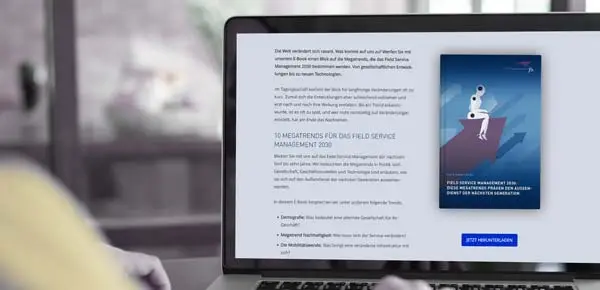
BLOG / SOLUTIONS · SERVITISATION
SERVITISATION: FIELD SERVICE OPPORTUNITIES FOR MANUFACTURERS
20 May 2022 · Christoph Bertram
Experts see the strategy as a revolution similar to that brought about by the just-in-time concept or lean manufacturing. Here, we dig in to the history of servitisation and reflect what this means for scheduling and dispatch teams.
WHAT IS SERVITISATION?
Servitisation describes a business model trend away from the pure sale of a product towards the provision of (additional) services. For companies, this means rethinking what added value they can deliver and how they can retain their customers. A famous quote by Harvard professor Theodore Levitt illustrates this:"People don’t want to buy a quarter-inch drill. They want a quarter-inch hole."
– Theodore Levitt
THE TREND FROM PRODUCT PURCHASE TO SERVICE ORDER
The fact that service is relevant for turnover (especially in the after-sales area) has long been recognised. The following expression reflects this well:"The first machine is sold by the sales department, the second by the service department."
– Unknown
Through servitisation, manufacturing companies are simply following the change in demand. Instead of offering a product for sale, they market a combined offer of product and service. For customers, this means that they have less work to do, integrating the product and can concentrate on their core business.
For manufacturing companies, the combined approach means more turnover per customer without much effort; selling the required 'know-how' that is readily available. In its completion, servitisation becomes product-as-a-service or solution-as-a-service.
THE DIFFERENT TYPES OF SERVITISATION
In servitisation, experts distinguish between three different types of services with their different scopes:- Base Services: These are options that can be added to a physical product, for example spare parts service, installation and set-up on site or application training for staff.
- Intermediate Services: These are services that ensure that the product is always functional and operational, for example regular field inspections, maintenance and servicing.
- Advanced Services: Customers no longer buy the product itself, but rather a specific service provided by the company, for example leasing machines or the "power by the hour" model of Bristol Siddeley or Rolls-Royce (see below).
SERVITISATION AND THE PRODUCT-SERVICE RELATIONSHIP
In the context of servitisation, buyers, experts, and service companies often move to a so-called Product-Service system. It is created when a product is linked with suitable services to form a new overall package. Under this system, and as the relationship matures, product and service is weighted differently. What results is a shift in balance and responsibility:- Product oriented: Product is in the foreground and is only complemented by individual field services such as installation, maintenance and repair.
- Integration oriented: Additional services such as financing, disposal of old equipment or training are intended to facilitate the acquisition and integration of the product.
- Service oriented: True product-service system where both elements are essential, for example sale of a heavy plant equipment in combination with a monitoring service (corresponding to Intermediate Services).
- Use oriented: Selling a function instead of a product, for example through a leasing service for machines and equipment.
- Results oriented: Service completely replaces the product, for example by offering a gardening service instead of selling a lawn mower.
EXAMPLES OF SUCCESSFUL SERVITISATION
The potential for long-term value creation sounds great, but how does this look in practice? The following examples of a product-service operations (derived from product ranges) illustrate servitisation best practice for the manufacturing industry:I. THE ROLLS-ROYCE 'POWER BY THE HOUR' OFFER
Bristol Siddeley, a manufacturer of aircraft engines, came up with the idea of offering its engines to airlines as early as the 1960s. This is, to not simply sell conventionally, but make products available for a transparent, fixed price. A fixed price per flying hour was agreed. The Invoice per flight hour gave the business model its name: 'Power by the hour'. After Rolls-Royce bought the company in 1968, however, this early innovation in servitisation was initially left to be forgotten.Around 15 years later, management took up the basic idea again and developed a new concept based on servitisation with 'TotalCare'. For a fee, airlines now acquired the 'provision of an engine including monitoring, maintenance and repair'. Billing was based on operating hours.
Advantages of servitisation:
- Less fluctuation in engine sales
- Increase in turnover through integration of repair, maintenance and spare parts
- Quality and durable engine design with low maintenance are rewarded
On the airline side, the concept also brings many advantages. In fact, the 'power by the hour' principle enabled the emergence of modern low-cost airlines in the first place, because they no longer need so much capital to enter the market:
- Fewer financial risks
- Plannable operating costs
- Better availability for engines
- Reduced downtime through monitoring and regular maintenance
Other industries and companies such as the tool manufacturer HILTI have meanwhile taken up the 'power by the hour' concept and make their products available to customers, including maintenance and servicing, for a fixed price.
II. ICI-NOBEL – A SERVITISATION SUCCESS STORY
As a manufacturer of explosives for quarries, ICI-Nobel suffered from intense price pressure and erratic customers who could not be tied down. The weak competitive position could have meant the end. Instead, the management invoked the strengths within the company: competences for carrying out and optimising blasting.Instead of continuing to compete in the competitive market for explosives, ICI-Nobel changed its offer from a pure product to a service for quarry owners and operators; the planning, preparation, and execution of blasts corresponding exactly with market demand. Up to now explosives had only been a means to an end.
By almost perfectly satisfying the needs of its customers, ICI-Nobel not only achieved higher profits, but also better customer loyalty. The quarry operating companies appreciated the benefits of servitisation; they no longer had to employ skilled workers or store dangerous explosives, but still made the same profits.
NEW BUSINESS MODELS BRING NEW FIELD SERVICE CHALLENGES
If you want to think along the lines of servitisation, think from your customer's perspective. Consider what management thought leader Peter Drucker said:"What the customer buys and considers value is never a product. It is always a utility – that is, what a product does for them."
– Peter Drucker
The best way to promote servitisation in your company is to start with the introduction of base services and aftersales services. Through the gradual expansion of field services, you gain experience in this area and can constantly improve your service. If, on the other hand, you wish to immediately begin Advanced Services, you'll require extensive planning. In addition, you first have to convince your customers of this concept instead of introducing them to the additional services step by step.
In mechanical and plant engineering, new concepts such as condition monitoring and predictive maintenance contribute to servitisation. It is important that you train your field service technicians accordingly. The more the focus of your business shifts to services, the more important it becomes to create workflows that support your field operations in the best possible way. Last but not least, optimised field scheduling and real-time route planning is required. A high quality and the ability to react dynamically to the event of disruption leads to satisfied customers - and to vastly increased sales potential. Remember:
"Quality is remembered long after the price is forgotten."
– Aldo Gucci
REAL-TIME SCHEDULING TOOLS TO SUPPORT SERVITISATION
To discuss the features of workforce management software to assist field scheduling and first-time-fix, book a short demo or contact us at info@fastleansmart.com.Read more:
What is After-Sales field service?
Reduce service complexity with innovative FSM software
Cut these 3 costs with Engineer Diary Management software
FLS: The ClickSoftware alternative for Field Service Management
Modern Workforce Management Software means resource optimisation

CHRISTOPH BERTRAM
Marketing
+44(0) 1183 800189
Send email
Christoph Bertram has been writing within the workforce software solutions sector for over 10 years. As an editor in the HR sector, he dealt with cloud technologies early on, later as an online editor and content manager with digitalisation in the skilled trades. He has been writing about route planning and field service management for FLS and the Solvares Group since 2021.




